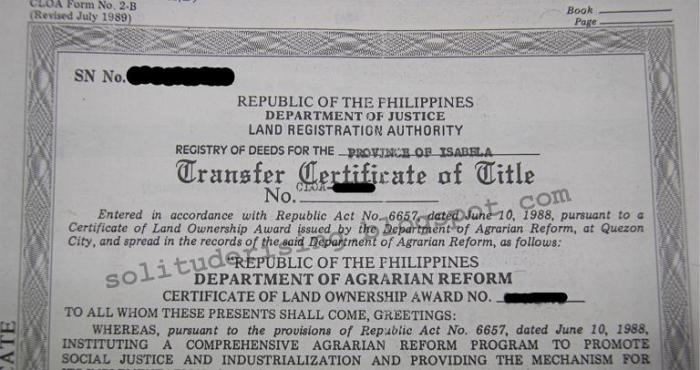“I strongly believe that the government,
particularly the national agency concern with this subject,
shall go down to the bottom line of the issue
and prove whether or not these
are already the prevailing theories in the ground”
(Photo credits to the owner)
I was astonished by my personal knowledge that Certificate of Land Ownership Award (CLOA), a certification issued by the Department of Agrarian Reform (DAR) to land beneficiaries covered by the agrarian reform law, is used as security deposit for rentals, conditional sale and antichrisis (prenda), among others. In the long run, the agrarian reform beneficiary can no longer till their hard-owned land and put to an eminent danger of losing the land because of the greater possibility of potential failure to redeem it over the price tag agreed between both parties.
Can we blame the farmers?
Of course, not.
The transactions they are into are consequences of their circumstances. Mostly, agrarian reform beneficiaries (ARBs) are in the state of poverty and the only means they have are the land they given to them by law. Without any other means aside from the land, they will find ways to look and find sources of income in order to survive, together with their families. The collateral they possess which is the land will now be the only object they can offer.
Can we blame the other party who got hold of the land?
No, not of course.
These parties provide cash as investment. They will pour certain amount relatively equal to the value of the land for economic gains out of their investment. In some cases, the transactions are even considered as an act of goodwill or in form of benevolence by providing the needed cash amounts when the ARBs need them most like hospitalization, death, tuition fees or to cover expenses in going abroad by a family member in the hope of finding greener pasture for the family.
Why is this so?
For an amateur in economics, I can offer few hypothesis of the premises mentioned.
- In real experience, the program primarily focuses on distribution of lands to ARBs. While it is true that the objective of agrarian reform is equitable distribution of lands to the tiller-farmers, the activity should not stop after distributing but it must continuously be connected to production, processing and marketing.
- Most if not all ARBs are not organized. With the exception of former plantation employees who are beneficiaries of the land of agricultural plantations, most of the beneficiaries are individually awarded with land which make them most vulnerable to economic backlash compared to those who are organized.
- There is no tangible program to educate and guide the ARBs of which crops best matches the features and components of the land awarded.
- Most of the time, even if there are available seeds and land preparation are subsidize, full blown production and processing support are rarely provided.
- ARBs are on guessing game and some are reliant of what are the trends in other municipalities and provinces of which crops to plant, thereby deprive them of opportunities to find the right buying prices of their crops. Most of the time, instead of expecting higher return of their investments of time, effort and money, their income are not even enough to pay the borrowed capital.
- The existing law of a five (six)-year period of prohibition from selling their land is a weak legal safety nets to protect land ownership. Absolute prohibition of sale is stronger.
- Because of limited or even lack of access to existing government program especially credit facilities of government financial institutions (banks) and inability to avail knowledge and skills products provided by government agencies (DA, DENR) for free, it is hard or even harder for ARBs to avail viable and sustaining opportunities in developing their land.
- There are fewer programs of collaborative, coordination and cooperation of programs, projects and activities with other government agencies entrusted to support and assist farmers. If there are, these are not systematically institutionalized to alleviate the situation of ARBs.
- ARBs are left unattended to position themselves in the supply chain, as such, they cannot make good to compete the existing demands in the market.
- Land development from distribution to preparation, to production, to processing, up to marketing should have been done by the ARBs in the concept of a business venture. Contrarily, most if not all of the ARBs are deprived of even the most basic and the most fundamental information for them to utilize effectively and efficiently to be productive.
Because the 10-enumerated items above are just hypothesis, I strongly believe that the government, particularly the national agency concern with the subject, shall go down to the bottom line of this issue and prove whether or not these are already the prevailing theories in the ground. If true, then corrective measure is necessary, relevant, practical and timely thing to do to rectify the challenges faced by the program.
Otherwise, the value of agrarian reform will be wasted.
How much is the value of your land?